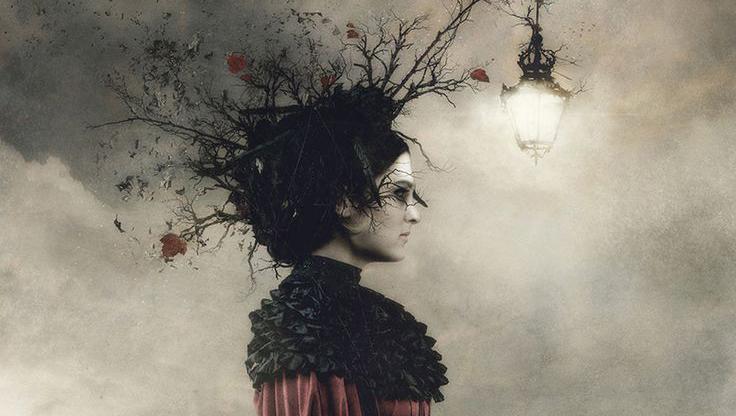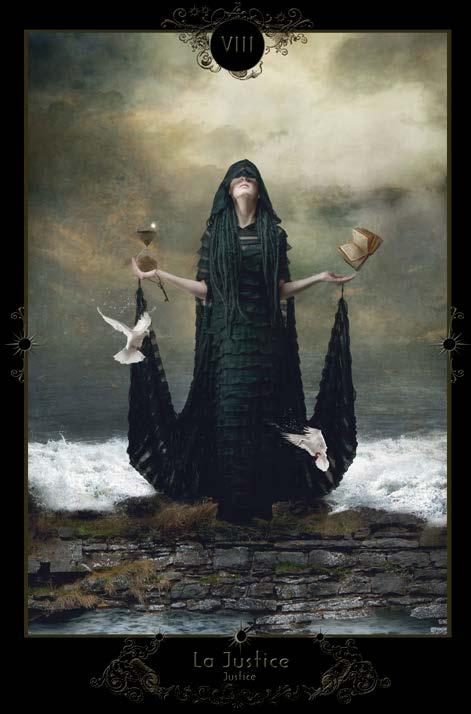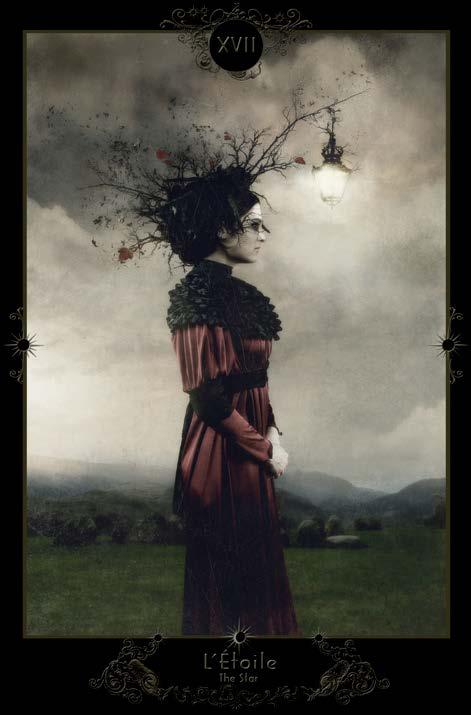Article taken from Issue #32 || Autumn 2015
Print || Digital
Throughly exploring an artwork by Rusty McDonald of DividingME Photography is like viewing an achingly lovely landscape through fog, or listing to beautiful music under water. There’s a mystical veil over the figures, mysterious esoteric symbolism in the images seen. The viewer can easily imagine that the pattern presented by a flying bird, budding branch, and rolling wave form an ancient symbol with great import. So it seems a natural progression that Rusty would work on creating a tarot deck from his images.
Rusty begins with a series of photographic images, often taken at his studio in North Carolina. He then layers these images using invisible digital thread to stitch them carefully together and combining them with textures and patterns that he gathers photographically from virtually anywhere, from a walk in the neighborhood to a visit to a mountain top. Once he completes an image, the viewer can no longer tell what was once “real” and what is purely imagination. It’s a kind of “visual alchemy,” as Rusty describes it.
There is an antiqued and somewhat dream-like look to Rusty’s images. A long-time admirer of the look of ambrotypes and ferrotypes after they’ve aged, he tries to give a “slight wink” towards early photography in his own work, making it painterly but also using “textures and overlays for scratches and slight flaws that are present in aged tintypes.”
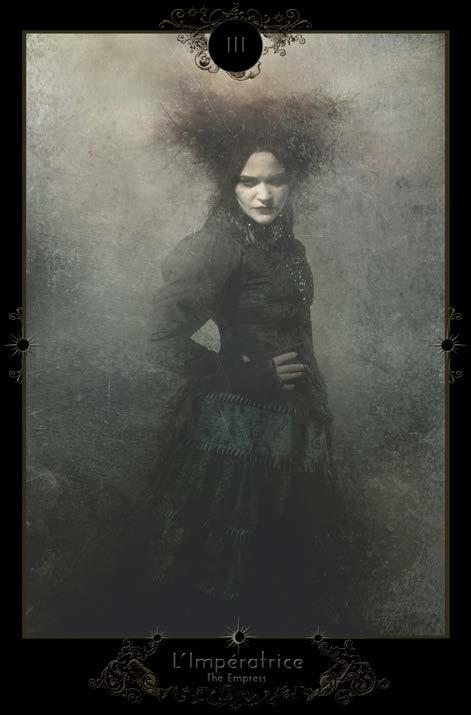 He often draws the titles of his pieces from references to mythology and philosophy. The relationship between an artwork and its title is important to Rusty’s work; sometimes the title precedes the actual piece. “The images are sometimes fragmentary and sit incomplete for months until the title comes. Once I have the title, the intent becomes clear, bringing everything together.”
He often draws the titles of his pieces from references to mythology and philosophy. The relationship between an artwork and its title is important to Rusty’s work; sometimes the title precedes the actual piece. “The images are sometimes fragmentary and sit incomplete for months until the title comes. Once I have the title, the intent becomes clear, bringing everything together.”
His use of mythic reference is sometimes fascinatingly obscure. (With the title of an image Rusty once created from my photograph, he introduced me to a mythic water-fey creature I’d never even heard of before, the Aloja, or Dona d’aigua, of Catalan mythology.) The influence of myth on Rusty’s life and work began when he was a child living in Germany and Iceland. He and his family traveled around Europe often, visiting such places as Loreley Rock … places “shrouded in legend.” His best friends were books. “As a child in Germany, I spent time exploring castle ruins and ancient forests; I read the Grimms, Andersen, and Tolkien. My mother had a copy of Sitchin’s The Twelfth Planet that left me thumbing through old Bibles looking for imagery of the Nephilim; it really got my imagination going.” These interests have followed him over the years.
The idea of the tarot deck began with a meeting between Rusty and couture clothier Kambriel. After admiring her work for years, Rusty reached out to Kambriel to see if she would be interested in collaborating. They first worked together when Rusty photographed an original Kambriel gown for musician Amanda Palmer’s The Grand Theft Art Companion book. They quickly discovered that they had a lot in common, and started doing photo shoots together; Rusty’s photography, Kambriel’s fashion. “Without being conscious of it,” Rusty recalls, “we were already creating the tarot. We were chatting over a glass of wine, and spent the next few hours exploring the idea.
It was a bit of magick. We had already created many of the Major Arcana. We didn’t set out with the intention of creating a tarot, but I think we were open to the energy and made a conscious decision to follow it wherever it led and no matter how long. It’s my wish that our tarot be a functional divining tool with the imagery serving as vehicle for messages from the universe.”
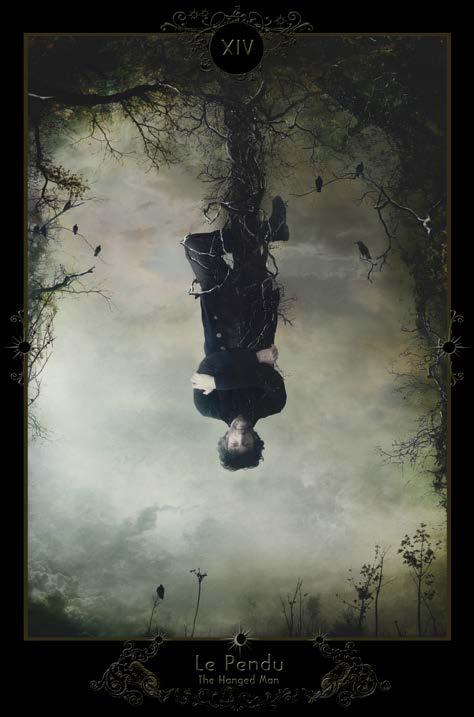 A couple of years after the tarot project began, Rusty had the opportunity to photograph author Neil Gaiman for a couple of tarot card images. “Kambriel [who had created garments for Neil and his wife Amanda in the past] had reached out to Neil, showed him examples of the work we had done on the project up to the point, and asked if he had any interest in being involved. He did!” Neil posed for, among other images, the Hanged Man card, dangling from a vine by one foot with his arms crossed across his chest.
A couple of years after the tarot project began, Rusty had the opportunity to photograph author Neil Gaiman for a couple of tarot card images. “Kambriel [who had created garments for Neil and his wife Amanda in the past] had reached out to Neil, showed him examples of the work we had done on the project up to the point, and asked if he had any interest in being involved. He did!” Neil posed for, among other images, the Hanged Man card, dangling from a vine by one foot with his arms crossed across his chest.
Neil Gaiman is not the only recognizable face in the tarot. Vampire author Michelle Belanger also appears on a card, and by the time the deck is completed you might see another familiar face or two from various creative fields. But the overall goal is clear. “Throughout the process, our intention has been to create an enchanting, elegant functional tarot. Each card is a unique piece of artwork imbued with the arcane. Ideally the final cards will have some form of embossing, gilt-edged and elegant, perhaps with the Major Arcana utilizing lenticular printing. We’ve spoken to a publisher, but our ideal scenario would be for our tarot to resonate with a publisher reading this, who would bring their own passion to the project in regard to the practical and finished product.” No doubt the final result will be a thing of beauty, cherished and thumbed through until worn by all who use it.
Article taken from Issue #32 || Autumn 2015
Print || Digital




























